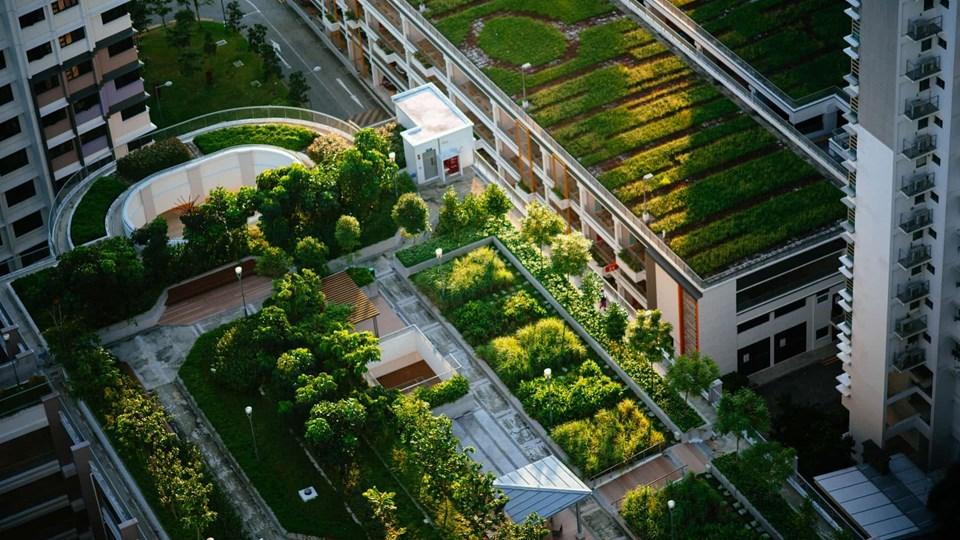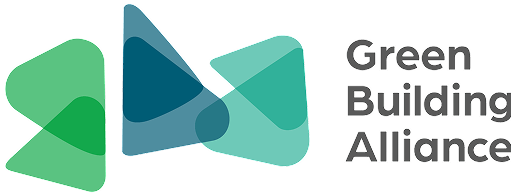Green Roofs
A green roof is a vegetative layer grown on a rooftop of a building. Also known as roof gardens, these green roofs serve as a large contributor to energy efficiency of buildings.

Green roofs reduce the temperature of the building and the surrounding air in multiple ways:
- Shading to the top of a building
- Evapotranspiration: plants in a green roof absorb water through their roots and then use surrounding heat from the air to evaporate the water
While some roofs can reach temperatures of up to 90°F or more in the summertime, green roof features can allow green roofs to actually be cooler than the surrounding air temperature. This in turn mitigates the urban heat island effect.
Features of a Green Roof
Multiple layers work together to produce a green roof’s high efficiency and quality:
Vegetation
The top layer of a green roof consists of vegetation. Plants should be chosen based on the type of roof, surrounding climate, and condition of the building. For flatter roofs and stronger buildings, taller and heavier vegetation can be used. Lighter and shorter vegetation is recommended for slanted roofs.
Growing Medium
The growing medium is the foundation for all vegetation on the top layer. Medium type, mixture and depth area will depend on the plants chosen for the green roof. A wind erosion layer, commonly made of burlap jute blankets, can also be installed to prevent wind from blowing topsoil off the roof.
Root Barrier
Root barriers are used when incorporating deep-rooted plants such as trees and shrubs. A root barrier prevents roots from reaching the membrane on the bottom layer, which if punctured, could cause roof leaks and decay. Common materials used for the root barrier layer are foil or plastic.
Drainage
A drainage layer is installed to adequately remove excess water from a green roof. Green Roof Solutions states that drainage systems are designed to ensure stormwater can be used by plants for extended periods of time without oversaturation of the entire green roof system. Note that this layer can also be found above the root barrier layer as well.
Insulation
The insulation layer is the protector of the membrane layer below. The insulation prevents the weight of the green roof from crushing the insulation and impairing the membrane. A light weight extensive green roof can include insulation below the membrane.
Membrane Protection
The roof’s membrane needs protection to prevent deterioration. The protective layer can be a slab of lightweight concrete, insulation, thick plastic, copper foil, or any combination of these.
Membrane
A membrane is the bottommost layer of a green roof, and is the main separation between the green roof above and the structural supports below. Due to the excessive water amounts associated with green roofs, the membrane must be strong enough to support this water weight and prevent water from seeping through.
Types of Green Roofs
There are generally two types of green roofs that differ by cost, depth of growing medium, plant types, and the potential for accessibility or use.
Extensive green roofs are simpler, lighter-weight systems commonly seen on residential buildings. Extensive green roof design incorporates a rugged, durable roof that requires little maintenance and no human interaction. Vegetation consists of hardy, weather-resistant plants that can adapt to extreme climates.
Intensive green roofs, on the other hand, resemble a traditional roof. There is almost no limit to the plants that can be used on these roofs, or the weight. Intensive roofs are commonly used for public areas that are accessible to and welcoming to people, allowing them to enjoy the green roof area. Common differences between the two roof types are listed below.
| Extensive Green Roofs | Intensive Green Roofs | |
|---|---|---|
| Common Roof Type | Residential, Slanted Roof | Commercial, Flat Roof |
| Planting Medium | 1.6 – 6 in. | 6+ in. |
| Manageable Weight | 10 – 35 lb / ft2 | 150 lb / ft2 |
| Used Vegetation | Drought-tolerant succulents, grasses | Plants, shrubs, gardens, trees |
| Base Cost | $10 / ft2 | $25 / ft2 |
| Amount of Required Maintenance | Low | High |
A green roof may include components of these two types of green roof systems and be referred to as either semi-intensive or semi-extensive green roof.
Benefits of Green Roofs
A few of the many benefits of green roofs are listed below. For further detail, check out greenroofs.org.
Aesthetic Improvement
Aside from their sustainable aspects, green roofs can be a beautiful addition to any building and can be designed to become a public area for building occupants and guests. Greenroofs.com states that these public areas can increase a sense of community and overall public safety.
Energy Reduction
The need to heat and cool a structure reduces drastically due to the thermal efficiency of green roofs. Acting as a natural shade and a heat absorber for a building, a green roof can significantly reduce cooling costs by as much as 25%, depending on the type of climate in which a building is located.
Increased Market Value
Installation of a green roof has been shown to increase the marketability of a building and add a value of 6%-15%. Significant aesthetic effects accrue to the owner, occupants, and the surrounding community.
LEED Certification Points
A green roof has the potential of earning LEED points for a building in multiple credit categories.
Moderate the Urban Heat Island Effect
The urban heat island effect is created when green space is replaced by buildings and hardscape, which tend to absorb heat at higher rates. This results in urban areas being hotter than nearby rural areas. Heat primarily comes from rooftops in urban areas since they are commonly painted black or other dark colors that absorb rather than reflect heat. Installation of green roofs can lower the surrounding air temperature and help moderate the urban heat island effect³.
Reduced Air Pollution
The reduced energy demand resulting from green roofs reduces air pollution and greenhouse gas emissions related to energy production. Plants also remove air pollutants and greenhouse gas emissions through two processes: dry deposition, and carbon sequestration and storage. Lastly, green roofs help slow the rate of ozone formation by reducing overall air temperatures.
Saved Costs
Although installation costs are higher than traditional roofs, the lifespan and low maintenance of a green roof can result in vast cost savings. Research from the University of Michigan showed that with initial roof costs of a green roof and a conventional roof relatively being $464,000 and $335,000, the green roof would actually save around $200,000 over its lifetime²! People can also manage their own installation, cutting down costs significantly.
Stormwater Management
Depending on size, density, and type, green roofs can capture stormwater and return it to the atmosphere through transpiration and evaporation. According to greenroofs.org, 70-90% of precipitation can be retained in the summer and 25-40% in the winter. Green roofs can also reduce stormwater runoff by holding water within the substrate and, therefore, delaying runoff time. A green roof also makes it possible to eliminate roof drains and other stormwater management infrastructure.
Urban Food Production
Green roofs provide the possibility of growing edible gardens on top of buildings. Urban food production reduces the woes of long-distance food supply and contributes to community nutrition and social interaction.
Related Links
Green Roofs for Healthy Cities
References
- Barmore, M., Peck, M. (2019). 2019 Annual Green Roof Industry Survey. Green Roofs for Healthy Cities. https://cdn2.hubspot.net/hubfs/4115293/GreenRoofIndustrySurvey2019Report.pdf (PDF)
- Walbridge, S. (2016, August 3). The green roof: a worthwhile investment. Michigan State University. https://www.canr.msu.edu/news/the_green_roof_a_worthwhile_investment
- Using Green Roofs to Reduce Heat Islands. (n.d.). United States Environmental Protection Agency. https://www.epa.gov/heatislands/using-green-roofs-reduce-heat-islands
